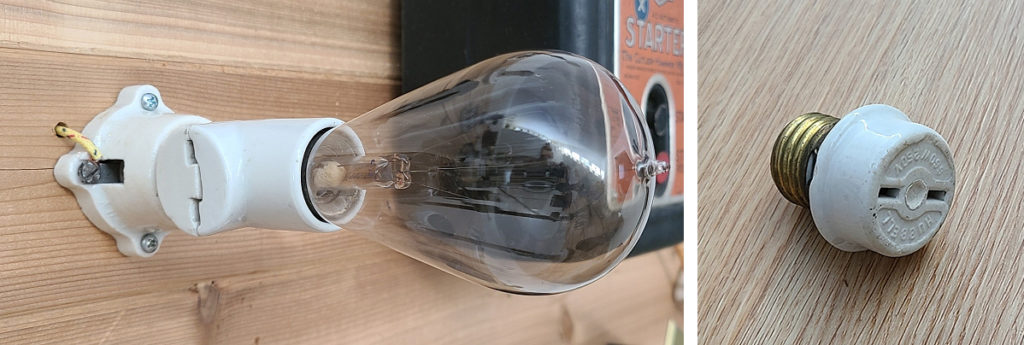AUBURN HEIGHTS PLUGGED IN
Over the 18 years that Tom Marshall wrote historical articles for the Weekly News, he would mention that his grandfather, Israel Marshall, built Auburn Heights with “modern” electric lights powered by a D.C. generator located in Marshall Brothers Paper Mill. Auburn Heights remained D.C. (direct current) powered until the estate was supplied A.C. power from Delaware Power & Light Company (predecessor to today’s Delmarva Power) in the 1930s.
While we’ve been inside Auburn Heights many times, it wasn’t until recently that we noticed something unique in how the mansion’s electrification was done. The mansion still retains many of the early-1900s push-button light switches with bright brass wall plates and original ceiling chandeliers and light fixtures. While scarce, one finds several two-blade (no ground) duplex electrical receptacles in most of the rooms. Only rooms such as the kitchen and study, which have seen remodeling, have more modern electrical fixtures and the occasional 3-blade grounded receptacle.
When Israel and his family moved into Auburn Heights in late 1897, the house would not have had electrical receptacles installed as they had not yet been invented! How did electrical appliances such as a fan or toaster get ‘plugged in’ during the first decade or two at Auburn Heights?
Answer
For a recent holiday event, we chose not to use the ceiling fixtures at Auburn Heights because most have modern, cold-white LED lamps installed that do not fit the period of the house with respect to color (electric lamps in the original fixtures would have emitted a yellowish spectrum candle-flame color typical of the glowing carbon lamp filaments of the era). To properly light the areas people would occupy, it was necessary to move some of the rarely used table and floor lamps to alternate locations as they mostly had proper incandescent bulbs remaining in them.
 In moving the lamp fixtures, we noticed that many two-blade electrical receptacles are installed in the baseboards! We also recalled that portable appliances such as table and floor lamps, fans, irons, and heaters weren’t invented until the mid to later 1890s. While the British had invented electrical plugs and receptacles in the late 1880s, it wouldn’t be until 1904 that American Harvey Hubbell patented the first detachable electric plug (right) and receptacle for use on American electrical systems. Thus, with Auburn Heights constructed in 1897, it is unlikely electrical receptacles were installed during construction.
In moving the lamp fixtures, we noticed that many two-blade electrical receptacles are installed in the baseboards! We also recalled that portable appliances such as table and floor lamps, fans, irons, and heaters weren’t invented until the mid to later 1890s. While the British had invented electrical plugs and receptacles in the late 1880s, it wouldn’t be until 1904 that American Harvey Hubbell patented the first detachable electric plug (right) and receptacle for use on American electrical systems. Thus, with Auburn Heights constructed in 1897, it is unlikely electrical receptacles were installed during construction.
Edison patented his design for the first commercial electric lamp in 1880. By the mid- and late 1880s the electrification of America had begun. America’s electrification utilized simple, almost primitive, electrical components. Electrical watthour meters weren’t invented until the later 1880s and didn’t see use until the turn of the century so power initially entered a home through only a fused disconnect (electricity use was billed by the total ‘candlepower’ of electric lamps a homeowner had). From the disconnect which included a fuse, various circuits powered lighting fixtures were controlled from a pushbutton switch on a nearby wall. While Auburn Heights’ wiring is installed in the walls, many homes of the era retrofitted with electrical power had the wiring routed on the walls!
The Marshalls, known to take advantage of the latest technologies, might have purchased or were gifted appliances such as electric fans or table & floor lamps. Such devices were most likely supplied with an “Edison Base Plug” as shown above. These plugs were equivalent to the base of an Edison electric lamp but with the wiring to the appliance instead of a glass envelope to contain a glowing carbon filament. A “plug” of the era was designed such that it could be screwed into an electric lamp socket in place of the bulb (or with an adapter that accepted a plug and lamp) without causing twisting of the wire!
Sometime in the early 1900s, appliances would have been available with Harvey Hubbell’s earliest patented plug which is similar to today’s plug and receptacle except that the two blades are coplanar as seen in the first image. Hubbell also offered several Edison to Hubbell adapters as shown in the images below.
Within a few years Hubbell redesigned and patented a new plug configuration. Hubbell changed the coplanar blade design to a parallel blade design and implemented several improvements. This is the plug configuration we use today. During the 19-teens, appliances generally came with either Hubbell’s coplanar or parallel plug configuration. This created the need for receptacles capable of accepting either configuration of plug (see images below).
When Israel eventually did add dedicated receptacles to the mansion, one can wonder what he might have had added and when. More than likely the addition of electrical receptacles occurred in the 1930s when the house was changed over from the mills’ D.C. power to DP&L’s A.C. power. The easiest way to add receptacles is at the baseboards where fishing wires down into the basement was easiest and there is a secure piece of baseboard lumber for fastening the receptacle’s electrical box. We note baseboard receptacles at a number of locations within the mansion. As the parallel blade plug had become standard, the mansion may have had combination coplanar and parallel plane receptacles installed (similar to the right image above) reflecting the fact that existing appliances of the early 20th century still in use in the mansion relied upon coplanar plugs.



